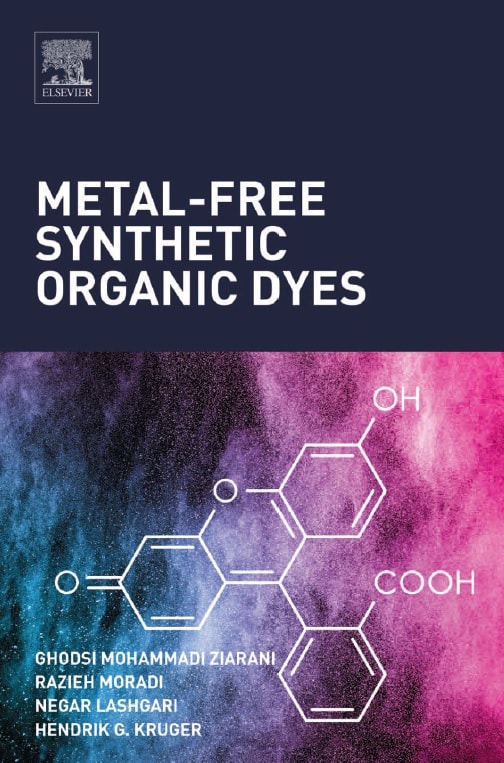
Contents
Biography ix
Acknowledgments xi
1. Introduction and Importance of Synthetic Organic Dyes 1
References 2
2. Anthraquinone Dyes 9
2.1 Synthesis of Anthraquinone Dyes 9
2.2 Application of Anthraquinone Dyes 15
References 16
3. Amine Dyes 19
3.1 Synthesis of Amine Dyes 19
3.2 Application of Amine Dyes 35
References 41
4. Azo Dyes 47
4.1 Synthesis of Azo Dyes 47
4.1.1 Synthesis of Monoazo Dyes 47
4.1.2 Synthesis of Diazo Dyes 63
4.1.3 Synthesis of Tetrakisazo Dyes 66
4.1.4 Synthesis of Polymeric Azo Dyes 66
4.1.5 Synthesis of Oxazole Azo Dyes 75
4.1.6 Synthesis of Pyrazole Azo Dyes 76
4.1.7 Synthesis of Thiazole Azo Dyes 77
4.2 Application of Azo Dyes 80
References 88
5. BODIPY Dyes 95
5.1 Synthesis of Boron Dipyrromethene Dyes 95
5.2 Application of Boron Dipyrromethene Dyes 104
References 106
6. Carbazole Dyes 109
6.1 Synthesis of Carbazole Dyes 109
6.2 Application of Carbazole Dyes 114
References 115
7. Coumarin Dyes 117
7.1 Synthesis of Coumarin Dyes 117
7.2 Application of Coumarin Dyes 123
References 123
8. Cyanine Dyes 127
8.1 Synthesis of Cyanine Dyes 127
8.1.1 Synthesis of Open or Closed Chain Cyanine Dyes 127
8.1.2 Synthesis of Hemocyanine Dyes 139
8.2 Application of Cyanine Dyes 144
References 146
9. Fluorene Dyes 153
9.1 Synthesis of Fluorene Dyes 153
9.2 Application of Fluorene Dyes 160
References 162
10. Fluorescein Dyes 165
10.1 Synthesis of Fluorescein Dyes 165
10.2 Application of Fluorescein Dyes 169
References 169
11. Imide Dyes 171
11.1 Synthesis of Imide Dyes 171
11.2 Application of Imide Dyes 174
References 175
12. Oxazine Dyes 177
12.1 Synthesis and Application of Oxazine Dyes 177
References 178
13. Phenothiazine Dyes 179
13.1 Synthesis of Phenothiazine Dyes 179
13.2 Application of Phenothiazine Dyes 181
References 182
14. Rhodamine Dyes 185
14.1 Synthesis of Rhodamine Dyes 185
14.2 Application of Rhodamine Dyes 188
References 190
15. Squaraine Dyes 193
15.1 Synthesis of Squaraine Dyes 193
References 195
16. Thiophene Dyes 197
16.1 Synthesis of Thiophene Dyes 197
16.2 Application of Thiophene Dyes 209
References 213
17. Triazine Dyes 219
17.1 Synthesis of Triazine Dyes 219
17.2 Application of Triazine Dyes 219
References 221
18. The Dyes Based on Several Chromophores 223
18.1 Synthesis of Dyes Based on Several Chromophores 223
18.2 Application of Dyes Based on Several Chromophores 236
References 239
19. Miscellaneous Dyes 245
19.1 Synthesis of Miscellaneous Dyes 245
19.2 Application of Miscellaneous Dyes 254
References 256
20. Conclusions 261
Abbreviations 263
Index 265
Introduction and Importance of Synthetic Organic Dyes
Synthetic dyes are manufactured from organic molecules. Before the discovery of synthetic dyes in 1856, the majority of natural dyes were prepared from plant sources: roots, berries, bark, leaves, wood, fungi, and lichens (Fig. 1.1) [1–4]. Batches of natural dyes were never exactly alike in hue and intensity, whereas synthetic dyestuffs can be manufactured consistently (Fig. 1.2) [5–10]. These dyes are made from synthetic resources such as chemicals, petroleum by-products, and earth minerals. The first human-made organic aniline dye, mauveine, was discovered by William Henry Perkin in 1856 [11], the result of a failed attempt in total synthesis of quinine. Since then, thousands of synthetic dyes have been prepared [12,13].
Synthetic dyes have been widely used in supramolecular chemistry not only to probe fundamental chemical interactions but also as components of functional materials [14–20]. Many of them have been widely utilized as fluorescent tracers in medicinal [13,21–23] and biological [24–30] applications and tumorinfected tissues tracers [31–33]. Organic dyes were also applied as photoredox catalysts in organic synthesis [34–37], laser [38–47], nanofiber [48], and in the paint industry [49–52].
During the past decade, numerous research attempts have been made on exploring new photosensitizers in the development of dye-sensitized solar cells (DSSCs). In the last decade, DSSCs have received considerable attention as one of the most promising new renewable photovoltaic cells alternative to conventional solid-state cells because of their advantageous properties, including low cost, environmental compatibility, and simplicity of the fabrication process. In recent years, metal-free organic dyes have been central in the development of DSSCs and are known to improve photovoltaic performance of DSSCs. In this regard, a variety of metal-free organic sensitizers have been developed [53–90].
Metal-free organic dyes offer the advantages of superior molar extinction coefficients, lower cost, and large diversity of molecular structures. Several versatile metal-free organic dyes have been synthesized over the past decade.
These novel photosensitizers have incorporated different organic groups such as coumarins [91], cyanines [92,93], hemicyanines [94], indolines [95], triphenylamines [96], bis(dimethylfluorenyl) aminophenyls [97], phenothiazines [98,99], carbazoles [100], polyenes [101], fluorenes [102], and many others.
Because of the widespread use of organic dyes and also tremendous interest of researchers in the area of synthetic organic dyes, and since there is no comprehensive book on the synthesis of different organic dyes, this book aims to review the synthetic organic dyes by classifying them based on their chemical structure and describing the synthesis and application of these structures. To make it easier for the reader to find the respective synthetic organic dyes, we chose to arrange this book based on the names of the organic dyes in alphabetical order. As far as possible, we have also indicated the color of the respective dyes in the various figures and schemes. Because of the vast area of organic synthetic dyes, it is virtually impossible to present all examples here; however, we attempted to summarize the most important structures and functional groups.
